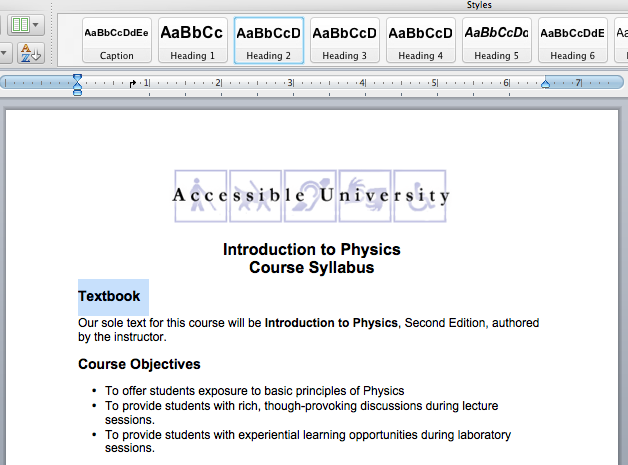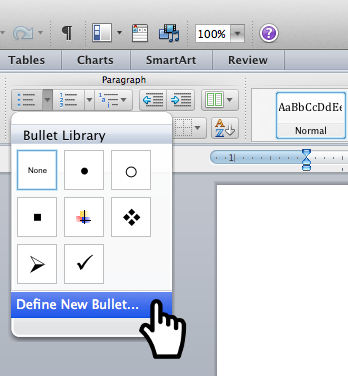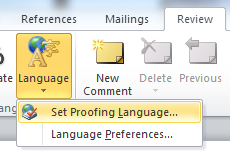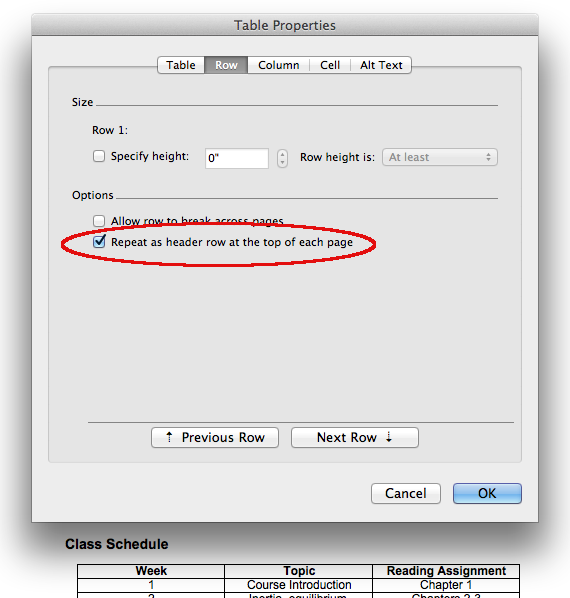Microsoft Word is a commonly-used application among individuals with a variety of disabilities, and is reasonably accessible. The text within Word documents can be read by assistive technologies such as screen readers and Braille devices. However, in order for Word documents to be fully accessible, authors must follow the core principles outlined in the Overview of Accessible Documents. Below are the basic steps for implementing these core accessibility principles.
Use Headings
Using good heading structure helps people without eyesight to understand how the document is organized. Screen reader and Braille users can also jump between headings, which makes navigation much more efficient than if there are no headings.
Making text larger and bold does not make it a heading. In order to convert text to a heading in Microsoft Word, you must use the built-in Heading styles like “Heading 1” and “Heading 2”, available under Styles in the Home tab of the Ribbon in Office versions 2010 and higher.

Headings should form an outline, using the “Heading 1” style for the main heading, and “Heading 2” for sub-headings. If there are additional levels of headings within the document’s outline, using “Heading 3”, “Heading 4”, etc.
Use Lists
Lists should be created using Word’s built-in tools for ordered (numbered) and unordered (bulleted) lists. Without using these tools, a list is not really a list, which makes the content more difficult for screen reader users to fully understand.

Note that both ordered and unordered lists are highly customizable. Just click on the arrow adjacent to the desired list button to design a list that meets your needs.
Add Alternate Text for Images
In most versions of Word, you can enter alternate text by right clicking an image and selecting Format Picture. Within the Format Picture dialog, select Alt Text.
To enter alt text in Office 2007, right click an image and select Size and Positioning. Then select Alt Text.
Identify Document Language
In Office 2010, the option is located in the Ribbon. Within the Review tab, select the Language button, then select “Set Proofing Language”.

NOTE: Currently language settings only effect accessibility of the Word document itself. They do not survive when exported to PDF. If PDF is the final format in which you intend to distribute your document, you will need to define language in the PDF directly using Adobe Acrobat Pro. For help see Fixing Inaccessible PDFs Using Acrobat Pro.
Use Tables Wisely
Word has limitations when it comes to making tables accessible. As explained in the Overview of Accessible Documents, tables can be very difficult for screen reader users to understand unless they include markup that explicitly defines the relationships between all the parts (e.g., headers and data cells). For a simple table with one row of column headers and no nested rows or columns, Word is up to the task. However, more complex tables can only be made accessible within HTML or Adobe PDF (accessible table markup can be added to the PDF using Adobe Acrobat Pro).
Often complex tables can be simplified by breaking them into multiple simple tables with a heading above each.
For simple tables, the only step necessary for accessibility is to identify which row contains the column headers. To do this in Word, select that row (Table > Select > Row), then right click the row and select “Table Properties”. This brings up the Table Properties dialog. In this dialog, click the Row tab, and check the checkbox that says “Repeat as header row at the top of each page”.

When Exporting to PDF, Understand How to Preserve Accessibility
There are right ways and wrong ways to export to PDF. The steps required depends on which version of Microsoft Word you’re using. For details see Creating Accessible PDFs from Microsoft Word.
Most Details from this page were gleaned from the University of Washington's Accessible Technology section.